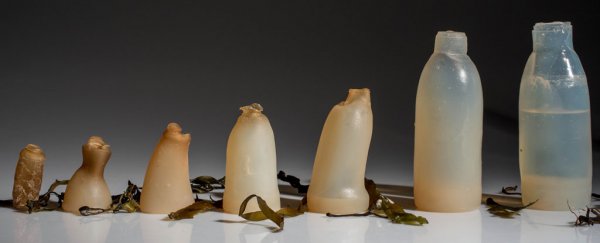With hundreds of millions of tonnes of plastic being produced globally every year, the race is on to find environmentally friendly alternatives to things like water bottles, so that huge amounts of unrecycled waste don't end up in landfill or the ocean.
Some of the most promising solutions could be garbage-eating worms and plastic-eating bacteria, but what if there's an even simpler approach? Icelandic product design student Ari Jónsson had such an idea: for a biodegradable drinking bottle made from a material that, unlike plastic, doesn't leave a near-permanent problem behind after it's been used.
"I read that 50 percent of plastic is used once and then thrown away so I feel there is an urgent need to find ways to replace some of the unreal amount of plastic we make, use and throw away each day," Jónsson told Dezeen magazine. "Why are we using materials that take hundreds of years to break down in nature to drink from once and then throw away?"
Looking at what materials could be used to create a drink bottle that breaks down after we no longer need it, Jónsson happened upon a powdered form of agar, a substance made from algae. When the powder is added to water, it forms into a jelly-like material, which when placed into a mould, can be shaped however you like. According to the designer, it will retain that shape until the bottle is drained.
"What makes this mix of algae and water an interesting solution is the lifespan of the bottle," Jónsson told Adele Peters at Fast Company. "It needs to contain liquid to keep its shape and as soon as it's empty it will start to decompose."
Jónsson, who studies at the Iceland Academy of the Arts, showed off the bottle as part of this month's DesignMarch exhibition in Reykjavik. He says water stored inside the bottle is entirely safe to drink, although it might absorb a bit of a salty taste from its agar vessel after a while.
You can even eat the bottle afterwards, if you feel a compulsion to do so. The taste of the bottle is "hard to describe," Jónsson told Fast Company. "I could say it's like seaweed jello, but I don't think many people have tasted something like that."
At this point, the biodegradable bottle is only a conceptual piece, and not yet ready for use as a serious alternative to plastics. Jónsson admits that the biggest issue with agar as a packaging material is that it tears quite easily – which isn't exactly something you want to deal with when it comes to carrying water around.
Nonetheless, the bottle's been designed to get people thinking about the products we use every day – and how there could be a better way of designing, manufacturing, and disposing of them.
"I can't claim that this is the perfect solution for our problem with plastic bottles," said Jónsson. "But it's a start and an idea that hopefully helps us to look at new ways to solve the problem… Switching to reusable bottles is also great, but that will have its pros and cons, just like my project, the more ways we can tackle this issue the better."
